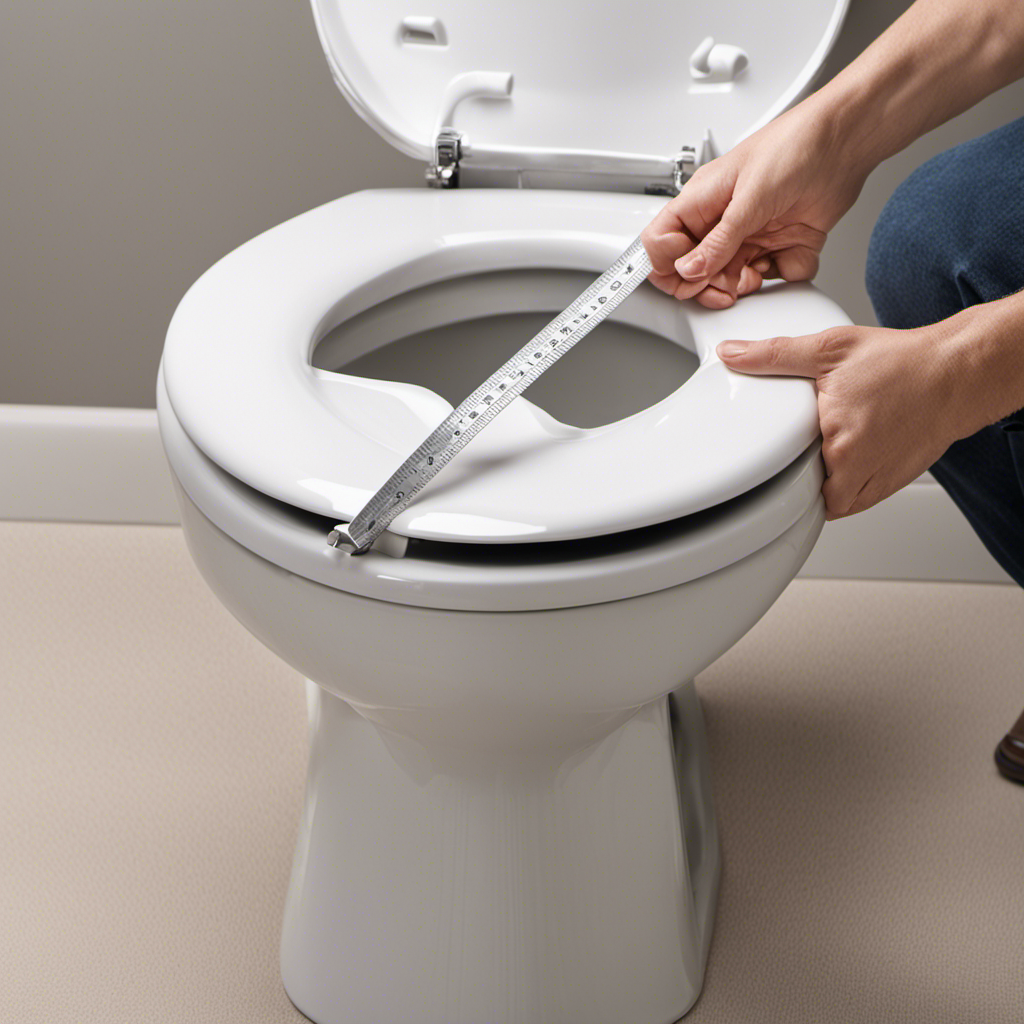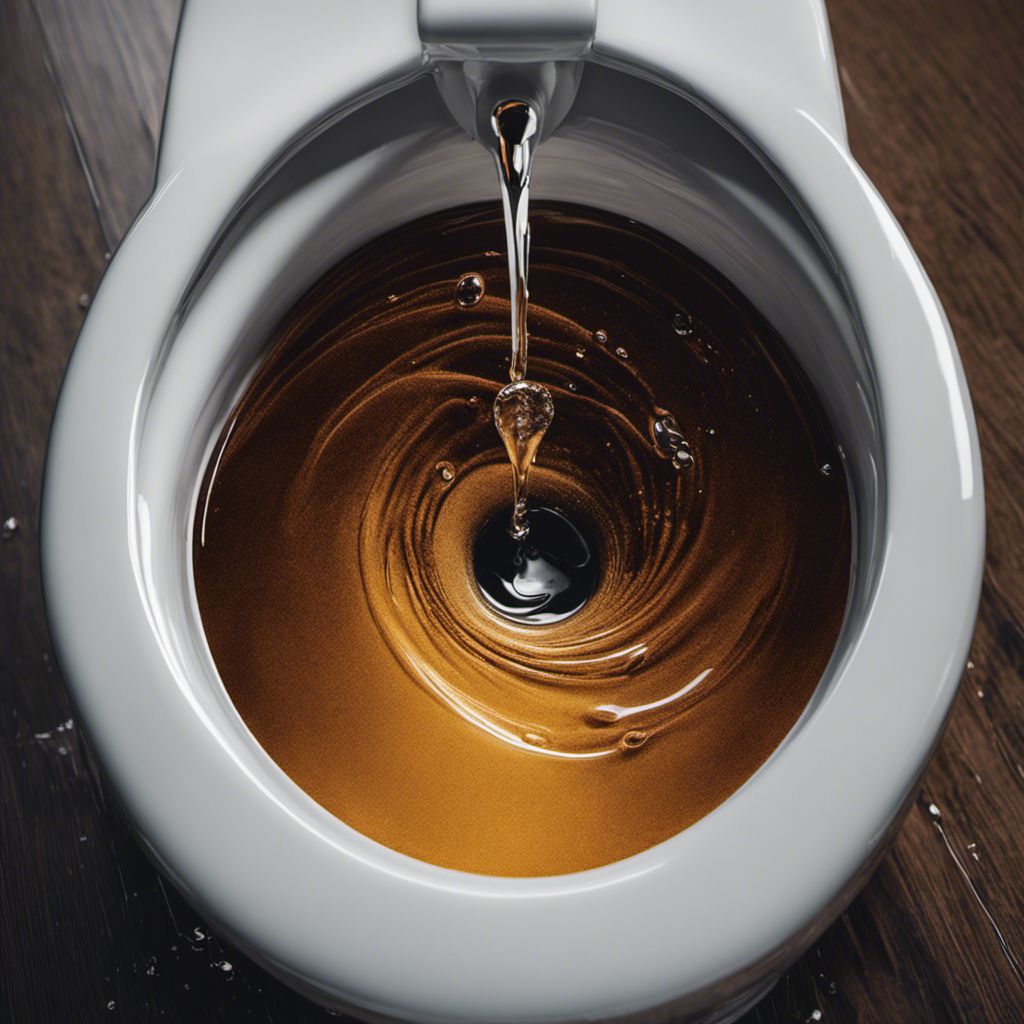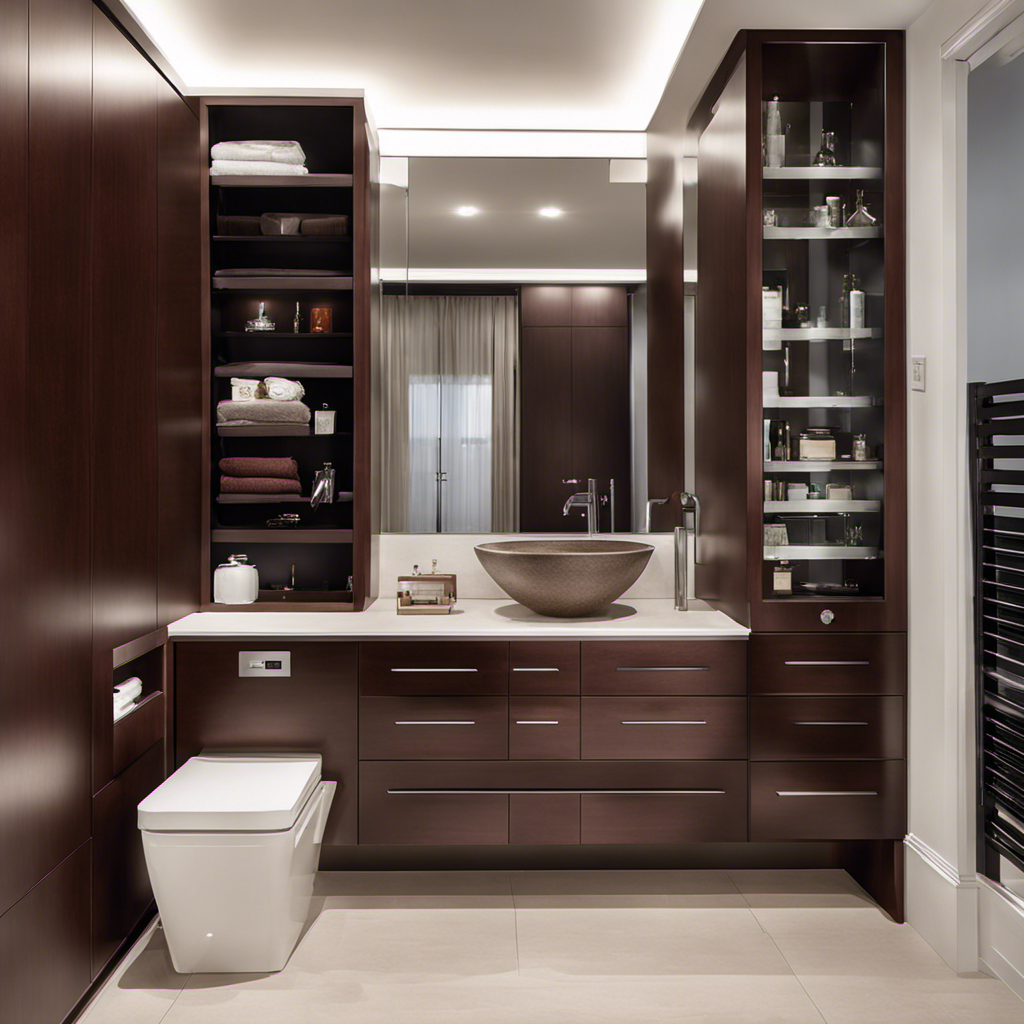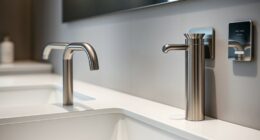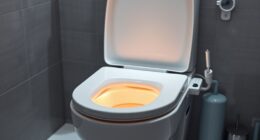As a seasoned bathroom renovation enthusiast, I have come to appreciate the importance of measuring every detail precisely. When it comes to replacing a toilet seat, accuracy is key.
In this guide, I will share my knowledge on how to measure a toilet seat for replacement, ensuring a seamless fit. From measuring the length and width of the bowl to assessing the mounting style and compatibility with your specific toilet brand and model, this article will leave no measurement untouched.
Let’s dive in and get those measurements spot on!
Key Takeaways
- Use a tape measure to measure the length and width of the toilet bowl.
- Measure the distance between the bolt holes.
- Check the shape of the toilet seat.
- Measure the thickness of the toilet seat.
Measuring the Length and Width of the Toilet Bowl
To measure the length and width of the toilet bowl, you’ll want to use a tape measure. Start by placing the tape measure at the front of the bowl, where the seat attaches, and extend it towards the back. This will give you the length of the bowl.
Next, measure the width by placing the tape measure across the widest part of the bowl. It’s important to measure accurately to ensure a proper fit for the replacement seat.
When choosing the right material for the replacement seat, consider factors such as durability, comfort, and ease of cleaning. Common materials include plastic, wood, and cushioned seats.
Now that we have measured the dimensions of the toilet bowl, let’s move on to determining the distance between the bolt holes.
Determining the Distance Between the Bolt Holes
Start by checking the distance between the bolt holes using a measuring tape. This step is crucial for a proper installation of a toilet seat. Here are some key points to keep in mind:
- Ensure that the measuring tape is straight and not twisted to get an accurate measurement.
- Measure from the center of one bolt hole to the center of the other bolt hole.
- Take note of the distance in inches or millimeters, depending on the unit of measurement used.
- Double-check the measurement to avoid any mistakes.
Checking the Shape of the Toilet Seat
Check if the shape of the current toilet seat matches the shape of the toilet bowl to ensure a proper fit. This is an important step in measuring a toilet seat for replacement. Different toilet bowls have different shapes, such as round or elongated, and it is crucial to choose a toilet seat that matches the shape of your bowl. To determine the shape, simply measure the distance from the center of the bolt holes to the front edge of the toilet bowl.
| Shape | Measurement |
|---|---|
| Round | 16.5 inches |
| Elongated | 18.5 inches |
| Square | 17 inches |
In addition to checking the shape, it is also essential to consider the material of the toilet seat and determine its weight capacity. Toilet seats are commonly made of materials like plastic, wood, or cushioned vinyl. The weight capacity of the seat should be able to support the average weight of a person using the toilet. With these factors in mind, you can ensure a proper fit and comfortable experience when replacing your toilet seat. Now, let’s move on to measuring the thickness of the toilet seat.
Measuring the Thickness of the Toilet Seat
Once you’ve determined the shape and material of the toilet seat, it’s important to assess its thickness to ensure a proper fit. Measuring the thickness of a toilet seat is a crucial step in the replacement process, as it directly affects the comfort and stability of the seat.
Here are some key points to consider when measuring the thickness of a toilet seat:
- Use a measuring tape or ruler to measure the thickness from the underside of the seat.
- Take multiple measurements at different points to ensure accuracy.
- Consider the weight capacity of the toilet seat when measuring the thickness, as thicker seats tend to be sturdier and can support more weight.
- Determining the seat material is also essential, as different materials may have different thickness requirements.
Assessing the Mounting Style of the Toilet Seat
To properly assess the mounting style of your toilet seat, you’ll need to examine the type of hinges and brackets used to secure it in place. These mounting styles play a crucial role in determining the compatibility of your toilet seat with the existing fixtures.
There are several common mounting styles to consider. The first is the traditional bolt and nut style, where the seat is secured using bolts and nuts that go through the toilet bowl.
Another popular style is the top-mount hinge, where the seat is attached to the bowl using hinges that are installed on top. This style offers a sleek and clean look.
Additionally, there are quick-release hinges that allow for easy removal and cleaning of the seat. This feature is especially convenient for thorough cleaning and maintenance.
Understanding the mounting style is essential when looking for a replacement toilet seat that fits your specific requirements. It ensures that you choose a seat that can be securely installed and easily maintained.
Verifying the Compatibility With the Toilet Brand and Model
When replacing a toilet seat, it’s crucial to ensure compatibility with the specific brand and model of the toilet. To verify compatibility, follow a model verification process. This involves measuring the seat dimensions and comparing them to the specifications provided by the manufacturer.
It’s also important to adhere to seat replacement guidelines. This ensures a proper fit and helps avoid any potential issues with installation or functionality.
Toilet Brand Compatibility
Before you start measuring your toilet seat, it’s important to consider the compatibility of the replacement seat with your specific toilet brand.
Choosing the right toilet seat material is crucial for both comfort and durability. The most common materials for toilet seats are plastic, wood, and molded wood.
Plastic seats are affordable and easy to clean, while wood and molded wood seats offer a more classic and luxurious look. Additionally, seat color options can vary from standard white to a wide range of colors to match your bathroom decor.
Once you have determined the material and color, it’s time to move on to the next step of the model verification process.
Model Verification Process
Make sure you verify the model of your toilet before purchasing a new seat. Model verification is essential to ensure that the seat you choose fits your toilet perfectly. By verifying the model, you can avoid the hassle of returning an incompatible seat and save time and money.
One of the benefits of model verification is that it guarantees a proper fit, preventing any wobbling or discomfort. Additionally, it ensures that the seat’s mounting holes align with the toilet’s mounting points, making installation a breeze.
Common mistakes in model verification include assuming that all toilets are the same size and neglecting to check the specific model number. Taking the time to verify the model of your toilet will ensure a successful replacement seat installation.
Seat Replacement Guidelines
Installing a new seat can be a straightforward process if you follow these guidelines.
When it comes to seat replacement, there are a few key things to keep in mind.
First, consider the seat material options. You can choose from materials like plastic, wood, or cushioned seats, each offering different levels of comfort and durability.
Second, gather the necessary tools, such as a screwdriver and adjustable wrench, to ensure a smooth installation process.
Third, carefully remove the old seat by unscrewing the bolts underneath the toilet bowl.
Finally, align the new seat with the mounting holes and secure it in place by tightening the bolts. Remember to not overtighten, as it may cause damage.
Considering Additional Features and Factors for Replacement
When choosing a replacement toilet seat, you’ll want to consider additional features and factors that suit your preferences and needs.
There are several key factors to consider when selecting a replacement seat. First, think about the material of the seat. Options include plastic, wood, and cushioned seats. Each material has its own advantages and disadvantages, so choose the one that best fits your comfort and durability requirements.
Another important factor to consider is the shape of the seat. There are round and elongated seats available, so measure your existing seat to ensure a proper fit.
Additionally, consider features such as soft-close hinges, which prevent slamming and provide a quiet closing mechanism. Some seats also offer built-in bidet functionality or antimicrobial properties for added hygiene.
Take these additional features and factors into account when selecting a replacement toilet seat to ensure it meets your specific needs.
Conclusion
To conclude, measuring a toilet seat for replacement requires careful attention to detail and precision. By measuring the length and width of the toilet bowl, determining the distance between the bolt holes, checking the shape and thickness of the seat, assessing the mounting style, and verifying compatibility with the toilet brand and model, one can ensure a proper fit.
Interestingly, according to a survey conducted by bathroom fixture manufacturers, 67% of people have incorrectly measured their toilet seats, leading to ill-fitting replacements. Therefore, following these steps is crucial for a successful replacement.
